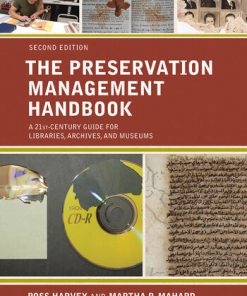Nine Practices of 21st Century Leadership A Guide for Inspiring Creativity Innovation and Engagement 2nd Edition by Gary Depaul, David Marquet, Edward Muzio ISBN 9781032226347 103222634X
$50.00 Original price was: $50.00.$25.00Current price is: $25.00.
Nine Practices of 21st Century Leadership A Guide for Inspiring Creativity Innovation and Engagement 2nd Edition by Gary Depaul, David Marquet, Edward Muzio – Ebook PDF Instant Download/Delivery: 9781032226347 ,103222634X
Full download Nine Practices of 21st Century Leadership A Guide for Inspiring Creativity Innovation and Engagement 2nd Edition after payment

Product details:
ISBN 10: 103222634X
ISBN 13: 9781032226347
Author: Gary Depaul, David Marquet, Edward Muzio
Nine Practices of 21st Century Leadership A Guide for Inspiring Creativity Innovation and Engagement 2nd Edition Table of contents:
Section I Demystifying 21st Century Leadership
1 Clarifying Why Leadership Is Confusing
Introduction
Reason 1: Leadership Is Like a Role but Different
Defining “Role”
Leadership Differs from a Role
Does “Leadership” Include a Set of Roles or Qualities?
Conclusion
Reason 2: Leadership Is More than a Set of Qualities
Many Authors Explain Leadership in Terms of Qualities
Leadership Qualities Are Necessary but Not Sufficient
Conclusion
Reason 3: Leadership Is Like a Skill but Different
Leadership Is Like a Skill
Leadership Is More than a Skill
Conclusion
Reason 4: Some Leadership Theories Overlap with Leadership Styles
Leadership Theories Explain Leadership Behaviors
Leadership Theories Referenced as Leadership Styles
Conclusion
Reason 5: Leadership Is Like Management, but Different
Introduction
Management Defined
Management Categories
Organization Managers
Process Managers
Project Managers
Managers of People
Three Performance Needs
Management and Leadership Can Accomplish the Same Tasks
Leadership Differs from Management
Conclusion
Reason 6: The Meaning of Leadership Is Changing
Summary
2 Defining 21st Century Leadership
Introduction
Definition of 21st Century Leadership and Desired Results
Desired Results
Introduction
Immediate Results
Fulfilled Needs
Removed or Reduced Performance Barriers
Improved Performance
Short and Long-Term Results
Cultural Results
Partnership Results
Individual Growth Results
Business Results
Societal Results
Conclusion
Maturing Mental and Moral Qualities, Capabilities, and Behaviors
Maturing Mental Qualities
Maturing Moral Qualities
Maturing Capabilities
Maturing Behaviors
Bidirectional
Seven Principles, Twenty-Six Beliefs, and Nine Practices
Summary: What to Do
3 Revealing Traditional Leadership and Assumptions
Introduction
Traditional Leadership Definition
Traditional Leadership Includes Accidental Leaders
The Extreme Case of Traditional Leadership
Why Anyone Would Practice Traditional Leadership
Traditional Leadership Assumptions
Assumption 1: Leaders Need Authority
Rationale
Why the Leaders Need Authority Assumption Is Wrong
Assumption 2: Leaders Are Heroes Who Leave a Legacy
Assumption 3: Intimacy Weakens Leadership
Assumption 4: Giving Away Power Weakens Leadership
Assumption 5: Only One Person—Typically a Manager—Functions as the Leader
Assumption 6: The Leader Is the Smartest
Assumption 7: Team Members Are the Cause of Unproductivity
Assumption 8: Team Members Cannot Be Trusted
Assumption 9: Team Members Are Less Important than Revenue, Profit, Operational Costs, and Leaders
Assumption 10: Talking Is More Important than Listening
Assumption 11: Recognition Is a Formal Process
Assumption 12: Leadership Requires Little or No Training
Assumption 13: Leaders Know How Effective Their Leadership Is
Summary: What to Do
4 Explaining 21st Century Leadership Principles and Beliefs
Introduction: Because of the Environment and Our Brains, We Need Guiding Principles
Seven Leadership Principles and Beliefs
Principle 1: Believe in Others
How Growth and Fixed Mindsets Affect Believing in Others
Mindsets
Fixed Mindset
Growth Mindset
People Can Shift Mindsets
How Fixed and Growth Mindsets Affect Believing in Others
Belief 1: Intelligence Isn’t Static and Can Be Developed Continuously
Belief 2: Everyone Can Practice Leadership Regardless of Role
Principle 2: Connect with Others
Psychological Safety
Ingroup and Outgroup
Belief 3: Being Vulnerable and Getting to Know Others Builds Trust
Without Trust, It Is Difficult to Maintain Relationships
Getting to Know Others Builds Trust
Belief 4: Sharing Your Mistakes Builds Credibility
Belief 5: Celebrations Build Community, Connect Events to Values, Renew Commitment, Promote Social Support, and Improve Everyone’s Well-Being
Principle 3: Put Others First
Belief 6: Giving Credit for Accomplishments to Others Is More Important than Taking Credit
Belief 7: Employees Serve Customers Before Serving Management
Belief 8: When Outcomes Are Disappointing, Accepting Responsibility but Never Blaming Is Critical for Personal Accountability
Belief 9: Leadership Is Action That Focuses on Others and Not the Actor
Belief 10: Volunteering Time, Energy, Resources, Ego, and Previous Priorities to Help Others Inspires Loyalty and Commitment
Principle 4: Give Up Control
Belief 11: Control Erodes Relationships
Belief 12: Leading Well Is about Empowering Others
Belief 13: By Making Yourself Dispensable, You Make Yourself Indispensable
Belief 14: Command and Control Is a Shared Responsibility
Principle 5: Encourage Growth
Belief 15: Helping Others Figure Out Their Development Enhances Their Ability to Contribute
Belief 16: Encouraging People to Grow and Leave Their Role Contributes to Organizational Growth
Belief 17: Allowing Teams to Make Mistakes Enables Them to Be Open with Their Mistakes and Learn from the Experience
Belief 18: If You Change the Conditions in Which Others Operate, You Can Change Their Behaviors
Principle 6: Collaborate with Others
Belief 19: Organizational Charts Limit Thinking
Belief 20: Considering Problems from a Systemic Perspective Minimizes Using Blame
Belief 21: Leadership Doesn’t Reside with One Person
Belief 22: Influence Comes from All Directions
Belief 23: Leadership Practices Work the Same with All Populations Including Peers, Customers, Supervisors, and Subordinates
Principle 7: Develop Leadership Practices Continuously
Belief 24: To Become Fluent in Leadership, You Need to Practice Leadership Regularly and Monitor Your Effectiveness
Knowledge
Conformational and Corrective Feedback
Belief 25: Knowing Everything about Leadership Isn’t Enough
Belief 26: Leadership Involves Helping Others Learn Leadership
Summary
Section II Improving Performance with Systemic Thinking
5 Practice 1: Analyzing Like Detectives
Introduction: Importance and Benefits of Analyzing Like Detectives
Characteristics of Analyzing Like Detectives
Rummler’s Fundamental Laws of Organizational Systems
Law 1: Understanding Performance Requires Documenting the Inputs, Processes, Outputs, and Customers That Constitute a Business
Law 2: Organization Systems Adapt or Die
Law 3: When One Component of an Organization System Optimizes, the Organization Often Suboptimizes
Law 4: Pulling Any Lever in the System Will Have an Effect on Other Parts of the System
Law 5: An Organization Behaves as a System, Regardless of Whether It Is Being Managed as a System
Law 6: If You Pit a Good Performer against a Bad System, the System Will Win Almost Every Time
Conclusion
Anatomy of Performance and the Human Performance System
Introduction
Anatomy of Performance of Organizations (Organization Level)
The Human Performance System (Performer and Process Levels)
Identifying Trouble Spots in the Human Performance System
Conclusion
The Performance Chain Model and the Six Boxes® Model
Introduction
Performance Chain Overview
Six Boxes® Model Overview
Common Mistakes with Influencing Behaviors
Mistake 1: Attempt to Influence without Focusing on the Valuable Accomplishments Needed to Support Desired Business Results
Mistake 2: Attempt to Influence without Collaborating with Other Departments
Mistake 3: Attempt to Influence with Only One Category
Mistake 4: Using Influence to Optimize a Subsystem While Compromising the Whole System
Troubleshooting with the Six Boxes® Model
Conclusion
Leading Examples
Individual Contributor Leading Example: Investigating Inventory Losses
Manager Leading Example: Investigating Opportunities through Skip-Level Dialogues
Executive Leading Example: Mapping the Primary and Support Processes
Background
Clint Analyzes the Organization
Results
Summary: What to Do
Summary
What to Do
Word of Caution
6 Practice 2: Diagnosing and Treating Like Doctors
Introduction: Importance and Benefits of Diagnosing and Treating Like Doctors
Characteristics of Diagnosing and Treating Like Doctors
Rummler’s RIP
Introduction
Phase I (Analysis and Diagnostics): Desired Results Determined and Project Defined
Phase II (Analysis and Diagnostics): Barriers Determined and Changes Specified
Phase III (Treatment): Changes Designed, Developed, and Implemented
Phase IV (Treatment): Results Evaluated and Maintained or Improved
Conclusion
Leading Examples
Introduction
Individual Contributor Leading Example: Diagnosing and Treating Project Management
Manager Leading Example: Diagnosing Ineffective Performers
Executive Leading Example: Diagnosing Fighting Fires
Summary: What to Do
Summary
What to Do
Word of Caution
7 Practice 3: Finding Key Behaviors Like Social Psychologists
Introduction: Importance and Benefits of Finding Key Behaviors Like Social Psychologists
Mistakes That Occur When Not Using This Practice
Reason 1: Difficulty Finding Key Behaviors
Reason 2: Promoted Due to Technical Capabilities
Reason 3: Choose Not to Develop Change Management Capabilities
Characteristics of Finding Key Behaviors Like Social Psychologists
Think Like Social Psychologists
Setting Goals and Measures
Systematic Approach for Finding Key Behaviors
Grenny et al. on Finding Key Behaviors
Duhigg on Finding Key Behaviors
Influencing and Adopting New Key Behaviors
Grenny et al.’s Six Sources of Influence for Influencing Key Behaviors
Duhigg and Influencing Key Behaviors
Leading Examples
Individual Contributor Leading Example: Inspiring Multidirectional Collaboration
Manager Leading Example: Changing the Selling Process
Executive Leading Example: Eliminating Tribal Knowledge
Summary: What to Do
Summary
What to Do
Word of Caution
Section III Supporting Change
8 Practice 4: Communicating Like Agents
Introduction: Importance and Benefits of Communicating Like Agents
Clarification: Differences among Practices Aligned to Communication
Characteristics of Communicating Like Agents
Tactics for Influencing Others to Take Action
Point of Clarification between Teams and Groups
Influence Tactics for Those Assigned to Manage Individual Contributors and Teams
Tactics for All Formal Roles to Influence Others to Act
Marquet’s Intent-Based Leadership (IBL)
Begin with the End in Mind
IBL
Conclusion
Drexler/Sibbet Team Performance Model
Leading Examples
Individual Contributor Leading Example: Knowledge Sharing across Teams
Manager Leading Example: Transitioning from Traditional C2 to a Shared C2
Executive Leading Example: Blaming the VP
Summary: What to Do
Summary
What to Do
Word of Caution
9 Practice 5: Directing Like Guides
Introduction: Importance and Benefits of Directing Like Guides
Characteristics of Directing Like Guides
Assessing Abilities Using Situational Leadership® II
SLII® Example
Techniques for Building Capability
Bandura’s Vicarious Learning
Cognitive Apprenticeship
Grenny et al.’s Tactics for Influencing Personal Ability
Leading Examples
Individual Contributor Leading Example: Helping an Aircraft Maintainer Build Competence
Manager Leading Example: Transitioning from Academic to Business Writing
Executive Leading Example: Transitioning a Training Department
Summary: What to Do
Summary
What to Do
Word of Caution
10 Practice 6: Nurturing Like Gardeners
Introduction: Importance and Benefit of Nurturing Like Gardeners
Characteristics of Nurturing Like Gardeners
Grenny et al.’s Structural Ability Tactics
Make It Easy: Handshaw and Performance-Support Solutions
Leading Examples
Individual Contributor Leading Example: Using Job Aids for Performance Support
Manager Leading Example: Establishing Department Standards
Executive Leading Example: Making Managers More Accessible by Changing the Space
Summary: What to Do
Summary
What to Do
Word of Caution
Section IV Adding Value
11 Practice 7: Facing the Unknown Like Lions
Introduction: Importance and Benefits of Facing the Unknown Like Lions
Characteristics of Facing the Unknown Like Lions
Serious Listening
Why Listening Is Undervalued, Underrated, and Challenging
Graves’ Five Levels of Listening
Miscommunication
Obtaining Feedback
Kouzes and Posner on Receiving Feedback
Goldsmith’s Feedforward Technique
Using 360° Feedback
Word of Caution
Giving Feedback
Leading Examples
Individual Contributor Leading Example: Hunter’s Leadership Assessment
Manager Leading Example: Identifying Annual Leadership Objectives Using 360° Feedback
Executive Leading Example: Obtaining Executive Team Feedback for a General Manager
Summary: What to Do
Summary
What to Do
Word of Caution
12 Practice 8: Developing Like Scouts
Introduction: Importance and Benefits of Developing Like Scouts
Characteristics of Developing Like Scouts
Robinson and Schroeder’s Mechanisms for Innovation: Idea Activators and Idea Mining
Kouzes and Posner’s Tactics for Generating New Ideas
Leading Examples
Individual Contributor Leading Example: Vendor Management Process
Manager Leading Example: Starting a New Training Department
Executive Leading Example: College Competition Sponsorship
Summary: What to Do
Summary
What to Do
Word of Caution
13 Practice 9: Communicating Like Broadcasters
Introduction: Importance and Benefits of Communicating Like Broadcasters
Characteristics of Communicating Like Broadcasters
Maxwell’s Eight Guidelines for Connecting with Others
Leading Examples
Individual Contributor Leading Example: Sharing Technical Expertise
Manager Leading Example: Leadership Development Breakfast Club
Executive Leading Example: Sharing Leadership at the Corporate Office
Summary: What to Do
Summary
What to Do
Word of Caution
Section V Continuing to Grow
14 Maturing and Sustaining Your Leadership Practices
Introduction
The Leadership Development Process
Step 1: Foundation
Step 2: Feedback
Step 3: Friction
Step 3.A: Share Results
Step 3.B: Apologize
Step 3.C: Ask for Help
Step 3.D: Get Started
Step 4: Follow-Up
The 21st Century Leadership Development Roadmap
Stage I: I Know
Characteristics
What You Need to Advance to Stage II
Stage II: I Don’t Know
Characteristics
What You Need to Advance to Stage III
Stage III: I Know That I Don’t Know
Characteristics
What You Need to Advance to Stage IV
Stage IV: I Don’t Know What I Don’t Know
Characteristics
What You Need to Maintain Stage IV
What to Do: Using the Roadmap to Sustain Your Journey
15 Considering Organizational Implications
Introduction
Managing the Strategy Portfolio
The Competitive Advantage of Having Employees at All Levels Practice Leadership
The Way Organizations Form, Monitor, and Refine Their Strategies
Building Teams with Diversity and Inclusion
Rethinking Leadership Development
Advancing 21st Century Leadership
Afterword: The Fundamental Attribution Error
Appendix I: 21st Century Leadership Definition, Principles, Practices, and Results
Appendix II: 21st Century Leadership Principles, Beliefs, and Practices Alignment
Appendix III: Traditional Leadership Assumptions and Related Consequences
Appendix IV: Nine Practices
Appendix V: Nine Practices 360° Feedback Diagnostic Tool
Appendix VI: Related Quality Terms
Appendix VII: Intent-Based Leadership (IBL) Manifesto
Endnotes
Bibliography
Index
People also search for Nine Practices of 21st Century Leadership A Guide for Inspiring Creativity Innovation and Engagement 2nd Edition:
21st century practices
leadership in 21st century
leadership in the 21st century pdf
nine competencies of leaders in the 21st century leader
nine competencies of leaders in the 21st century
Tags: Gary Depaul, David Marquet, Edward Muzio, Nine Practices, 21st Century Leadership, Inspiring Creativity Innovation
You may also like…
Computers - Security
Reference - Library & Information Science
Business & Economics - Management & Leadership
Education Studies & Teaching - Teaching & Teacher Training
Arts - Fashion
Computers - Security
Education Studies & Teaching - Educational Guidance & Counseling











